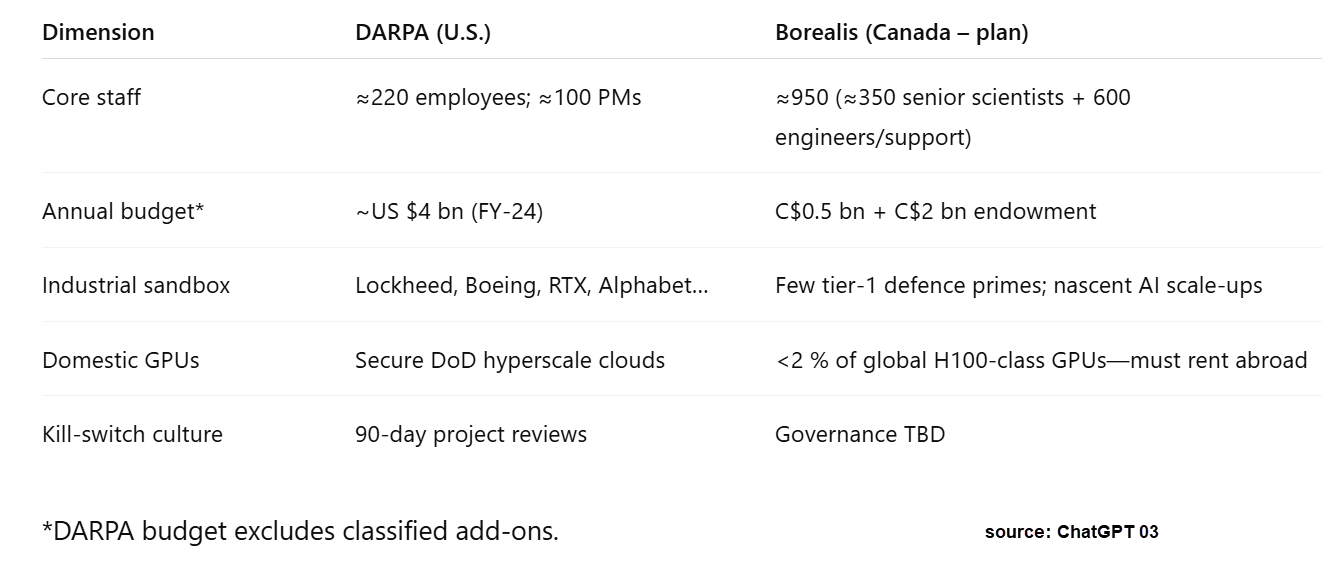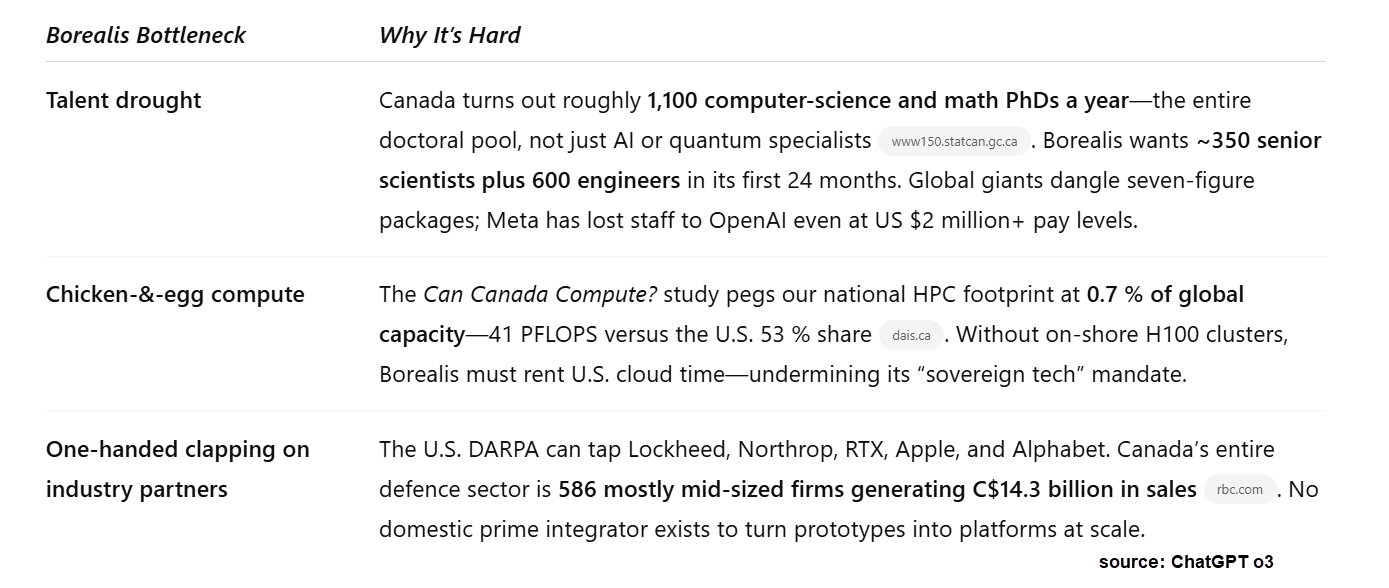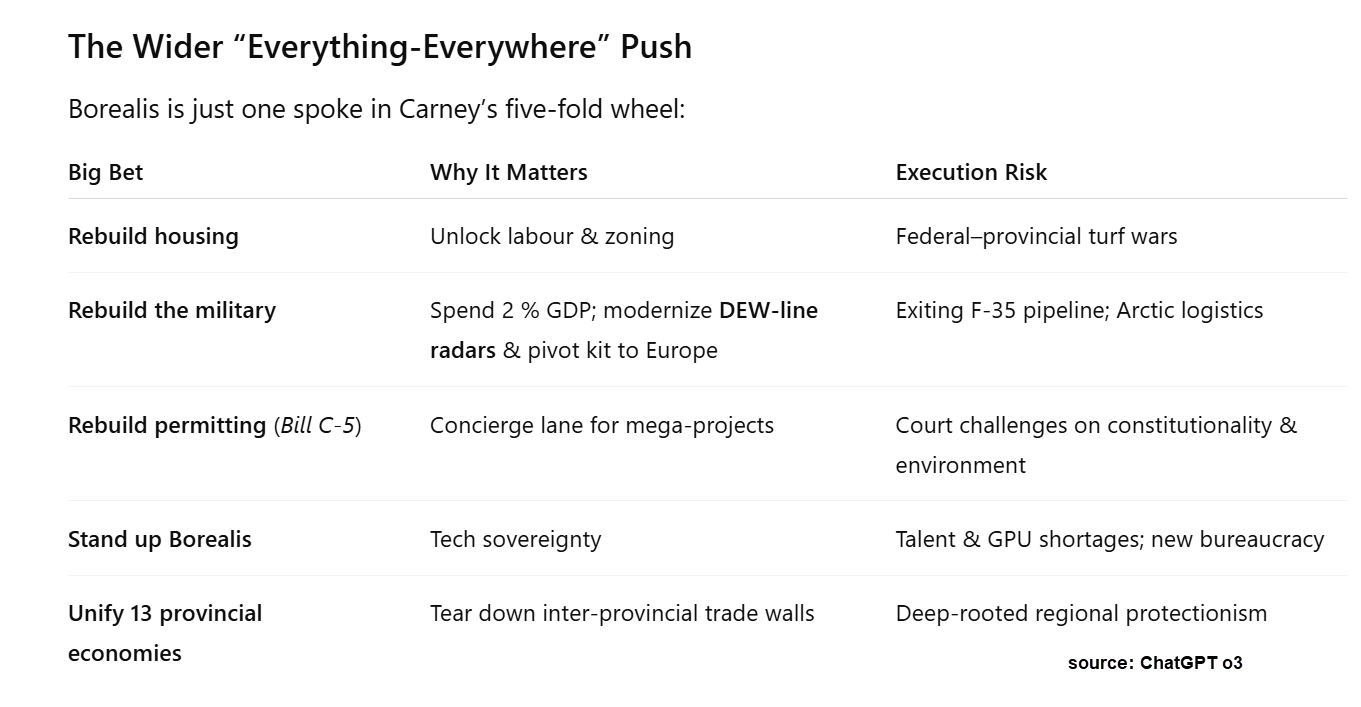From Sputnik to Borealis: Is This Canada’s Moon-Shot Moment?
Can Canada turn a hinge-point into a moon-shot?
The space age began with a beep. On October 4, 1957 the Soviet Union launched Sputnik I, a polished aluminum sphere that orbited the globe every 98 minutes and sent the West into technological shock.

Sputnik over North America
How DARPA Sparked America’s Tech Dominance
Washington reacted by creating the Advanced Research Projects Agency (ARPA)—today’s DARPA—built around a radical charter: keep America so far in front that it never again plays catch-up. Canada drew a very different lesson. Concluding that fast bombers were already obsolete in the age of surface-to-air missiles and ICBMs, Prime Minister John Diefenbaker cancelled the Mach 2 Avro Arrow interceptor on February 20, 1959 and pivoted to missile defense, installing the Distant Early Warning (DEW) radar line across the Arctic.
That decision scattered many of the Arrow’s engineers to NASA and U.S. defense contractors—a brain drain Canadians still lament whenever “big science” resurfaces.

DARPA inspired Have Blue image from ChatGPT
DARPA’s Playbook: Lean, Fast, and Fearless
Sixty-seven years on, DARPA remains astonishingly small ≈220 civil-service staff, about 100 of them rotating “program managers.” Their job is to frame audacious questions, fund the best external teams, and ruthlessly kill under-performers within 90 days. Out of that lean model emerged:
- Stealth flight—Have Blue→ F-117 → B-2
- BigDog quadruped robotics
- GPS, the Internet, Siri, and mRNA vaccine platforms
DARPA doesn’t build; it catalyzes.

What Is Project Borealis—and Why Now?
Prime Minister Mark Carney hopes to spark Canada’s own hinge-point. His plan: a C$2 billion endowment plus C$500 million annually to fund 18-month sprints in AI, quantum and cyber. Where Eisenhower faced Sputnik, Carney cites an escalating U.S. trade war and a “hollow-core” Canadian Armed Forces (CAF). He has also pledged to modernize the North Warning System—essentially a DEW line 2.0—so Canada can see over-the-pole threats in the hypersonic era.

Can Ottawa Really Pull Off Its Own DARPA?
Moon-shots come with moon-sized risks. Our probability-weighted view: only a 20-25% chance that Borealis meets its own key-performance milestones on time and on budget. Three structural gaps keep that success rate low:

Major Roadblocks to Execution
Fail-fast governance is DARPA’s secret sauce—but Canada’s track record is fail-slow. Auditor-General Karen Hogan’s June 10, 2025 report found that in over 80% of sampled federal tech contracts departments couldn’t show they were paying market rates; half lacked evidence on deliverables before writing cheques. In 2024, she commented, “If everywhere we look we find problems, we should expect that there are problems everywhere.” That is the culture Borealis must hack if it hopes to outrun the Arrow’s ghost.
These same weaknesses ripple through Carney’s “everything-everywhere” agenda: housing, CAF rebuild, mega-project permitting, Borealis, and dismantling inter-provincial trade walls. Each bet competes for the same scarce talent, leadership bandwidth, and procurement discipline highlighted above, some have the added complication of risking constitutional challenges for overstepping provincial turf.

What This Means for Investors
- Vision worth applauding—Ottawa is finally playing offence in deep tech and Arctic surveillance.
- Inputs remain scarce—People, GPUs, supply-chain partners.
- Governance will decide the spread—Borealis needs DARPA-style kill-switches and radical transparency.
- Probability <50%—Narrative upside is huge; execution risk just as large.
Borealis exemplifies Carney’s grand vision, moon-shot approach—leveraging the U.S. Tariff crisis as a reason to fundamentally reimagine how Canada works. Carney has accurately diagnosed Canada’s economic malaise (excessive regulation and bureaucratic bloat) but rather than cutting regulations he proposes entirely new bureaucracies—new levels of government power—to fast track projects and procurement. The Auditor General is probably asking herself the question investors should be: “what could possibly go wrong?”
Our Portfolio Positioning Strategy
As Canadians we celebrate Carney’s vision, as Investors and tax-payers we’re taking a “trust but verify” approach. If Carney can execute on his astonishing ambition, he will secure his place in history as one of Canada’s most consequential leaders.
Watch the Video: Project Borealis
Want to hear Glen’s take in more detail? Check out our latest video on YouTube and subscribe to stay up to date.
Curious how we’re positioning portfolios around Canada’s policy swing? Let’s talk.
Glen
